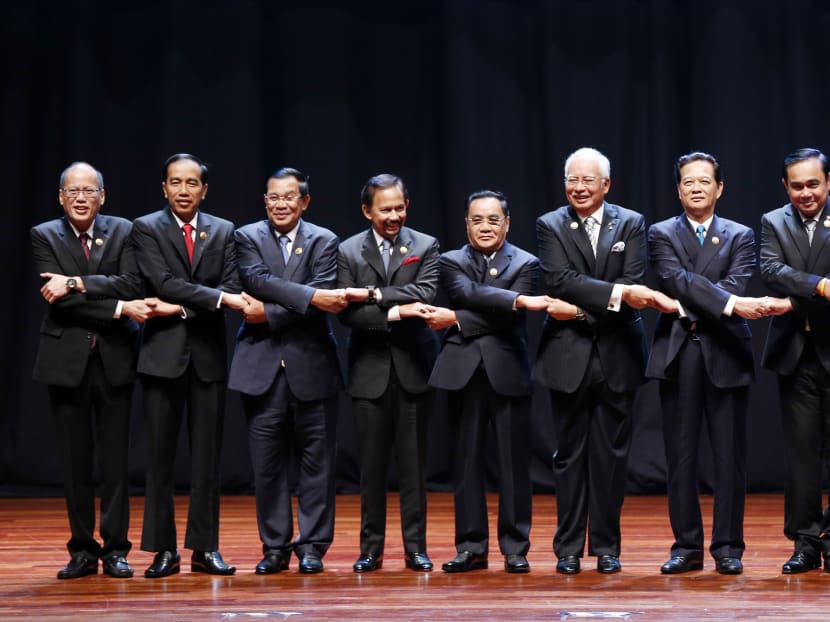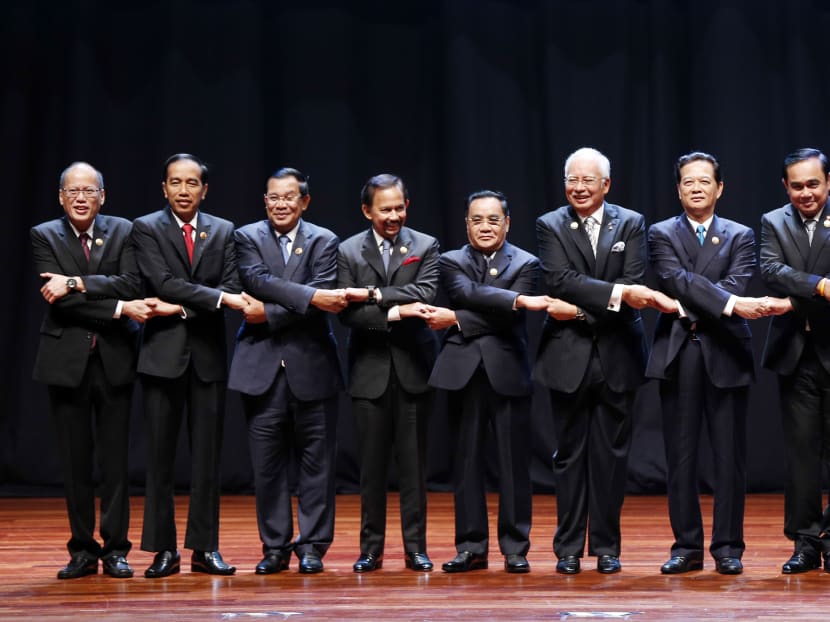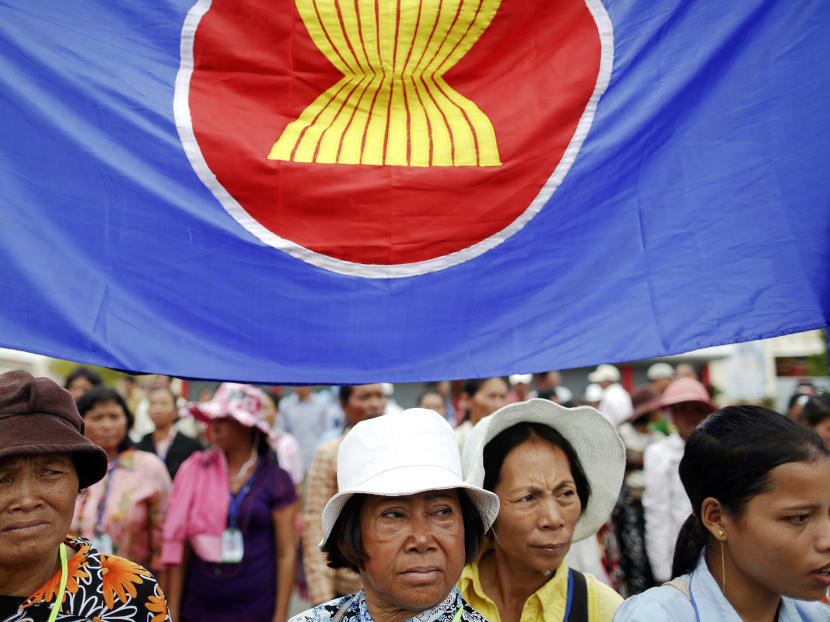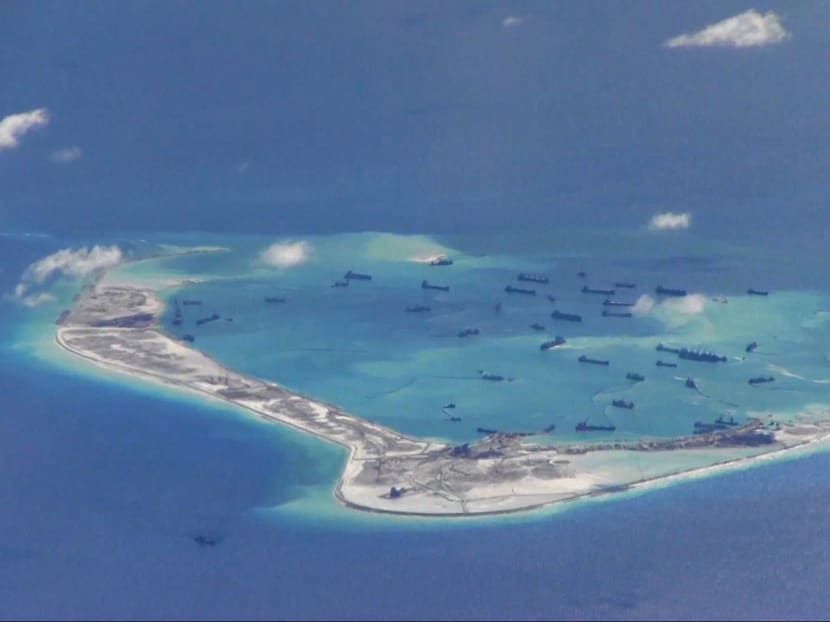ASEAN integration a work in progress — in more ways than one

ASEAN Leaders from left to right, Philippines' President Benigno Aquino III, Indonesia's President Joko Widodo, Cambodia's Prime Minister Hun Sen, Brunei's Sultan Hassanal Bolkiah, Laos' Prime Minister Thongsing Thammavong, Malaysian Prime Minister Najib Razak, Vietnam's Prime Minister Nguyen Tan Dung, Thailand's Prime Minister Prayut Chan-o-cha, Singapore's Prime Minister Lee Hsien Loong and Myanmar's President Thein Sein pose for photographs during opening ceremony of the Association of Southeast Asian Nations (ASEAN) summit in Kuala Lumpur, Malaysia, Saturday, Nov. 21, 2015. Photo: AP
jQuery.noConflict() ASEAN integration a work in progress — in more ways than one
Much remains on the agenda as ASEAN becomes an integrated community on Dec 31 and as Laos takes over the chair of the regional grouping.
Albert WaiAlbertWai [at] mediacorp.com.sg Published: Monday, 28 December 2015
In a grand ceremony in Kuala Lumpur last month, leaders of the Association of Southeast Asian Nations (ASEAN) formally established an integrated community that will begin on Dec 31.
As a sign that integration is an ongoing process, the grouping also launched a vision to achieve further cohesiveness as a community in the next decade.
The 10-year workplan contains refreshed blueprints for the three pillars — political-security, economic and socio-cultural — that support the ASEAN Community.
“One of the key priorities for ASEAN in 2016 is to implement the seamless transition into the new ASEAN 2025 blueprints as a way to keep the community-building momentum moving forward,” said Dr Tang Siew Mun, head of the ASEAN Studies Centre (ASC) at the ISEAS-Yusof Ishak Institute in Singapore.
Now, all eyes are on Laos as it takes over the chairmanship of the grouping next year and kicks off a new chapter in the region’s 48-year history.
Among the key goals for the grouping — which includes Brunei, Cambodia, Indonesia, Laos, Malaysia, Myanmar, the Philippines, Singapore, Thailand and Vietnam — is to function increasingly as a single market of 625 million people, boosting trade and attracting more investment.
The theme of Laos’ chairmanship is literal: Turning Vision into Reality for a Dynamic ASEAN Community. But some observers have already cast doubts on whether Laos can effectively manage one of the major political issues affecting ASEAN cohesiveness — the South China Sea dispute — given its close association with China.

The story of ASEAN integration has always been one of a work in progress.
“I think the next phase of integration (in the region) will be more akin to ‘change in continuity’, in the sense that the commitment of ASEAN members to cooperate and coordinate more closely is a constant,” said Ms Moe Thuzar, lead researcher for socio-cultural affairs at the ASC.
“The element of change, if you will, lies in the response to the changing global environment, which requires ASEAN members to evolve and adapt regional and national processes in tackling issues that cut across sectors and borders,” she said, adding that some of these issues include extremism, transboundary haze and human trafficking.
Ms Moe Thuzar
Lead researcher for socio-cultural affairs at the ASEAN Studies Centre in Singapore“With greater discussion and sharing, there will be more understanding of what ASEAN can or cannot do as an inter-governmental organisation, and the areas where national or sub-regional efforts can support or complement regional priorities.””
One of the most significant outcomes of increased ASEAN integration is the formation of an ASEAN Economic Community (AEC) this year, transforming the region into a single market and production base.
ASEAN’s combined gross domestic product of US$2.6 trillion (S$3.67 trillion) would make it the world’s seventh-largest economy.
More than 99 per cent of tariffs have reportedly been eliminated in Brunei, Indonesia, Malaysia, the Philippines, Singapore and Thailand to make the region more competitive. The newer members of ASEAN (Cambodia, Laos, Myanmar and Vietnam) will eliminate all tariffs by 2018, to allow them a longer time to adjust to the standards of the other, more advanced economies.
To be sure, there is some way to go before ASEAN’s economy is fully integrated.
The 2015 regional economic blueprint shows an implementation rate of 79.5 per cent, mainly due to the difficulties in harmonising regional and domestic rules in areas such as investment and free movement of labour.
Assistant Professor Kaewkamol Pitakdumrongkit, an expert on the AEC at the Centre for Multilateralism Studies in S Rajaratnam School of International Studies (RSIS), said that to resolve the outstanding items in the blueprint, domestic laws and regulations would have to be amended.
“Adjusting domestic laws and regulations is of course political, because changes will create winners and losers within the society,” she said.
“Losers are actually those in sectors that cannot compete in the open economy, and they often form coalitions blocking their government’s move to change the laws.”
On a more positive note, she noted that the 2025 AEC blueprint places more focus on ASEAN’s participation in Global Value Chains, or how different stages of production, trade and investments cut across different countries.
This is important for the regional economies as international investments and production is increasingly organised within such chains.
Beyond closer trade links, a longer- term priority of ASEAN is to build a stronger regional identity to pave the way for further integration.
Mr Lee Hsien Loong
Prime Minister of Singapore“People don’t think of themselves as being ASEAN, except when you have an ASEAN meeting and then you have singsongs together and you see what the ideal is...But to go from that ideal to a reality, I think there is some distance yet.”
“People don’t think of themselves as being ASEAN, except when you have an ASEAN meeting and then you have singsongs together and you see what the ideal is,” Prime Minister Lee Hsien Loong told the media after the last month’s summit meetings. “But to go from that ideal to a reality, I think there is some distance yet.”
Dr Tang of the ASC cautioned that the ASEAN Community project will fail if it did not have the support of the region’s 625 million constituents. It is therefore vital that ASEAN community-building brings tangible benefits to citizens of the member states.

Disputes in the South China Sea will continue to test regional unity next year and it remains to be seen if Laos can ring-fence the issue and prevent it from affecting other aspects of regional cooperation.
China claims most of the South China Sea by nine-dash line it has marked on maps to define historical borders over which it claims sovereignty. Brunei, Malaysia, the Philippines, Vietnam and Taiwan also claim parts of the South China Sea.
Manila has asked the Permanent Court of Arbitration in The Hague to affirm its right to areas within 200 nautical miles of its coastline, under the terms of the United Nations Convention on the Law of the Sea. Beijing refuses to participate in the arbitration.
Dr Richard Heydarian, a political science professor at De La Salle University in Manila, said there seems to be no common approach in ASEAN in creating a viable solution to the South China Sea dispute. With the slow progress on negotiations for a legally binding code of conduct, he noted that ASEAN is not even in a position to facilitate peaceful management of the issue.
“With Laos taking over the chairmanship of ASEAN in 2016, China is expected to flex some muscle and leverage its tremendous influence on the country in order to block any meaningful discussion on the South China Sea,” he added.
Beijing and Vientiane have close economic ties. China is Laos’ leading investor with reportedly more than US$5 billion (S$7 billion) worth of projects in mining, hydropower and agriculture.
“So the challenge for the region is to avoid another 2012 fiasco when Cambodia, another Chinese ally, held the chairmanship of ASEAN,” said Dr Heydarian, referring to a meeting of ASEAN ministers when the group failed to issue a joint communique for the first time in the bloc’s history because of disagreements over the South China Sea. Others are sanguine that the territorial disputes will not affect other aspects of ASEAN cooperation.
“Countries in the region are aware of the complexity and intractability of the South China Sea disputes and would wish to ‘compartmentalise’ them from other areas of cooperation,” said Dr Le Hong Hiep, a visiting fellow at the ISEAS-Yusof Ishak Institute.
“Much of the tension in the South China Sea has been between ASEAN claimant states and China, not among ASEAN members themselves. As such, other areas of ASEAN cooperation are likely to be maintained and promoted despite maritime tensions,” he noted.
Dr Le Hong Hiep
visiting fellow at the ISEAS-Yusof Ishak Institute“Much of the tension in the South China Sea has been between ASEAN claimant states and China, not among ASEAN members themselves. As such, other areas of ASEAN cooperation are likely to be maintained and promoted despite maritime tensions.”
Dr Le added that, as current coordinator of ASEAN-China relations, Singapore has an important role in managing the South China Sea issue.
Commenting on how Laos is expected to deal with the contentious South China Sea issue next year, Dr Tang of ASC said that he expects Vientiane to continue with the tone set by the Malaysian chair this year in maintaining a robust discussion on the sea.
“Laos appreciates the gravity of favouring China as doing so will undermine ASEAN unity and centrality, while potentially exposing China to criticism for muzzling ASEAN,” he said.







